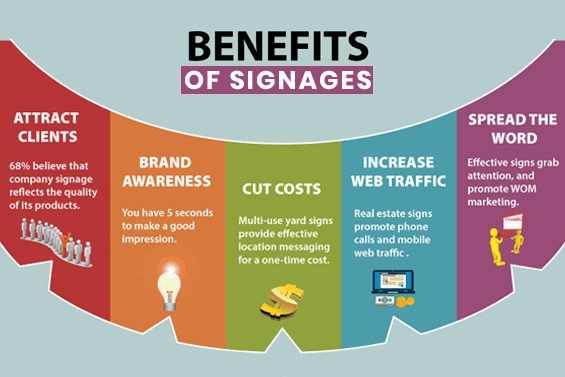summary
Despite its advantages, the implementation of interactive digital signage presents challenges, including high initial investment costs and the necessity for continuous content optimization to ensure effectiveness. As the landscape evolves, businesses must navigate these complexities while capitalizing on the potential of interactive digital signage to drive brand recognition and foster lasting customer relationships.
Historical Context
Digital signage has evolved significantly over the years, transforming from static displays to dynamic, interactive systems that enhance customer engagement. In its early days, signage primarily served a functional purpose, providing basic information and advertisements to passersby. However, as technology advanced, so did the potential of signage to convey messages more effectively and creatively.
Evolution of Signages
Prior to the widespread adoption of digital technologies, businesses relied heavily on traditional forms of signage, such as printed banners and posters. These static formats lacked the ability to adapt in real-time to changing customer needs or preferences. The introduction of digital signage marked a turning point, as businesses began to explore the capabilities of electronic displays that could showcase vibrant visuals, animations, and video content, capturing the attention of audiences in ways previously unattainable
segments
Rise of Interactive Displays
The push towards interactivity in digital signage began in the early 2010s, driven by advancements in touchscreen technology and the growing prevalence of smart- phones. Businesses recognized the value of engaging customers directly through their signage, leading to the development of interactive displays that allowed users to navigate content, make selections, and even complete purchases on-site. This shift not only enhanced customer experiences but also provided businesses with valuable insights into consumer behavior, enabling them to tailor marketing strategies more effectively
Integration with Modern Technologies
As digital signage technologies continued to evolve, new trends began to emerge. The integration of the Internet of Things (IoT) into digital signage systems allowed for seamless data exchange and real-time updates, making it easier for businesses to adapt their messaging to suit current trends and customer demands. Additionally, the introduction of generative AI further expanded the capabilities of digital signage, allowing for personalized content experiences that could cater to diverse audience segments
Current Trends in Interactive Digital Signages

Sustainability in Signages Design
With increasing environmental concerns, sustainability has emerged as a top priority for businesses in various industries. In 2024, a significant rise in the adoption of eco-friendly materials and practices in signage design and production is anticipated. Companies are increasingly utilizing recycled materials and energy-efficient lighting options, aiming to minimize their environmental footprint through eco-friendly sig- nage. This not only demonstrates a commitment to sustainability but also appeals to eco-conscious consumers who prioritize environmentally responsible brands
Advancements in Digital Signages Technology
Digital signage continues to dominate the advertising landscape, propelled by tech- nological advancements. In 2024, innovations such as high-definition displays and interactive video walls are expected to enhance the dynamic content delivery capa- bilities of digital signage. These features allow businesses to showcase captivating visuals, deliver targeted messages, and adapt content in real-time, providing unpar- alleled flexibility and effectiveness in audience engagement
Personalization and AI-Driven Content
The integration of artificial intelligence (AI) in digital signage is transforming the industry by enabling personalized and data-driven content strategies. AI-powered an- alytics help measure campaign effectiveness, track user engagement, and optimize content based on viewer behavior. This allows businesses to create hyper-person- alized marketing campaigns that resonate with target audiences, enhancing overall engagement and effectiveness. For instance, AI can analyze customer behavior, purchase history, and demographic information to generate tailored content that captures attention and drives sales
Interactive and Touchless Technologies
The rise of interactive digital signage is reshaping customer engagement by invit- ing users to interact with on-screen elements. Touchscreen technology facilitates navigation and interaction, enhancing the customer experience in retail settings. Moreover, touchless interaction technologies, such as gesture recognition and voice commands, have gained traction, providing intuitive ways for audiences to engage with digital displays without physical contact. This trend has become particularly relevant in public spaces due to heightened hygiene concerns
The Role of Augmented and Virtual Reality
Augmented Reality (AR) and Virtual Reality (VR) technologies are increasingly integrated into digital signage, offering immersive experiences that enhance engagement. These technologies enable users to interact with digital content overlaid on the physical environment or explore virtual worlds, making them popular in gaming, education, training, and experiential marketing
Industry Insights
The Rise of Total Experience Strategies
In contemporary business environments, organizations across various sectors are increasingly adopting total experience strategies that integrate both internal and external operations. According to Gartner, companies providing a comprehensive total experience are projected to outperform their competitors by 25% in satisfaction metrics by 2024, significantly enhancing both customer and employee experiences-. This holistic approach is evident in companies like Samsung, which supports projects from inception to completion, ensuring customers have the necessary tools for success.
The Role of Digital Signages
Digital signage plays a crucial role in enhancing customer experience and engage- ment. For instance, at St. Peter’s Square in Vatican City, visitors are captivated by stunning displays that create a memorable atmosphere during significant events. Similar implementations can be seen in various sports venues, such as Minute Maid Park, where Samsung upgraded substantial digital display systems to elevate the fan experience and operational efficiency. Furthermore, the Swiss Life Arena in Switzerland boasts the largest indoor LED cube in Europe, demonstrating the significant advancements in digital signage technology
User Engagement and Community Building
Utilizing digital signage for displaying positive reviews, social media posts, and user-generated content fosters a sense of community and trust among customers.
This real-time interaction enhances customer engagement and satisfaction, making individuals feel valued and appreciated[14]. Additionally, restaurants that provide clear nutritional information through digital signage can build trust with health-con- scious diners, encouraging repeat visits.
Interactive Technologies and Customization
The implementation of interactive ordering kiosks and customizable digital displays has become increasingly popular. These technologies not only streamline the or- dering process but also allow for personalized menu options, catering to individual customer preferences. This adaptability enhances customer satisfaction and contributes to a unique shopping experience that distinguishes businesses from their competitors.
Sustainability Trends in Digital Signages
As the digital signage industry evolves, sustainability has emerged as a prominent trend. Newer display models are being designed with energy-efficient materials that consume less power, thus reducing their environmental impact. This focus on eco-friendliness is anticipated to grow even more prevalent as businesses become increasingly aware of the importance of sustainable practices.
Market Dynamics and Challenges
The digital signage market has seen significant growth, particularly in the retail sector, which accounted for a market share of 21.6% in 2023. Retailers are increasingly adopting digital signage to enhance product promotion amid fierce competition. Despite the decreasing costs of components, the initial investment for large-scale installations can be substantial, posing challenges for smaller businesses that may find these costs prohibitive. Furthermore, businesses must prioritize continuous optimization and testing to ensure the effectiveness of their digital signage cam- paigns.
Metrics and KPIs for Measuring Effectiveness

When evaluating the success of digital signage campaigns, identifying and tracking the appropriate metrics and key performance indicators (KPIs) is crucial. These met- rics provide insights into audience engagement, content effectiveness, operational efficiency, and overall return on investment (ROI) for brand recognition initiatives.
Key Performance Indicators (KPIs)
Audience Engagement
Audience engagement is a vital KPI that assesses how effectively digital signage captures the attention of viewers. Metrics such as dwell time, interaction rates, and content engagement help determine the degree to which the content resonates with the target audience. High engagement levels indicate that the messaging is effective in driving viewer interest and desired actions
Brand Awareness and Recall
For campaigns aimed at prompting specific actions, conversion rates serve as a criti- cal metric. This KPI tracks the percentage of viewers who take desired actions—such as making a purchase, signing up for a newsletter, or visiting a website—after interacting with digital signage content. By measuring conversion rates, businesses can gain insights into the effectiveness of their digital signage in driving customer behavior and influencing purchasing decisions
Customer Feedback and Satisfaction
Customer feedback is crucial for gauging audience satisfaction and perceptions of digital signage campaigns. Gathering qualitative data through surveys, focus groups, and online reviews allows organizations to refine their messaging and strategies based on audience preferences and areas for improvement
Operational Efficiency
Operational efficiency metrics evaluate the performance and reliability of the digi- tal signage technology and infrastructure. Indicators such as uptime, maintenance costs, and system reliability ensure that digital signage campaigns operate smoothly, minimizing disruptions that could impact viewer engagement and overall campaign effectiveness
Methodologies for Defining KPIs
The S.M.A.R.T. method is a widely used framework for defining effective KPIs, ensuring that they are Specific, Measurable, Achievable, Relevant, and Time-bound. For example, a specific KPI could be the percentage of repeat buyers as a measure of customer loyalty, while a measurable KPI could be the number of social media interactions generated by a campaign. By adhering to the S.M.A.R.T. criteria, businesses can effectively track progress and optimize their digital signage strategies for enhanced brand recognition and customer engagement.
Benefits of Interactive Digital Signages for Brand Recognition

Interactive digital signage has emerged as a transformative tool for enhancing brand recognition across various industries. By leveraging its dynamic features, businesses can effectively engage customers and leave a lasting impression.
Enhancing Customer Engagement
One of the primary benefits of interactive digital signage is its ability to foster deeper customer engagement. Unlike traditional signage, interactive displays invite customers to participate actively in their shopping experience, thereby creating memorable interactions with the brand. Touchscreen interfaces allow users to browse products, access detailed information, and even engage in promotional activities, which not only enhances the customer experience but also increases dwell time, leading to higher conversion rates
Personalization of Brand Experience
The ability to deliver personalized content significantly amplifies the impact of brand messaging. Digital signage can be tailored to reflect the preferences and demo- graphics of the audience, ensuring that the brand resonates with them on a personal level. For instance, screens can showcase product suggestions based on past purchases, making customers feel valued and understood. This personalization fosters a connection that goes beyond simple transactions, cultivating long-term loyalty
Real-Time Updates and Communication
Digital signage allows businesses to provide real-time updates about promotions, events, or new product launches[25][28]. This immediacy keeps customers informed and engaged, creating an atmosphere that encourages interaction. The vivid displays are designed to capture attention, making it easier for brands to communicate their message effectively in busy environments
Consistency Across Multiple Locations
For brands operating in various locations, maintaining a consistent identity is cruci- al. Interactive digital signage enables businesses to showcase their logos, colors, and messaging uniformly across different venues[24][31]. This cohesion reinforces brand recognition and strengthens the overall brand image, ensuring that customers associate specific visuals and messages with the brand, regardless of where they encounter it
Driving Sales and Upsell Opportunities
In addition to enhancing customer engagement and brand recognition, interactive digital signage can directly contribute to increased sales. By guiding customers to ad- ditional products and upsell opportunities through personalized content, businesses can effectively boost their revenue. This strategic use of signage not only enhances the shopping experience but also aligns with business objectives, making it a win-win situation for both brands and customers.
Best Practices for Implementation

Implementing digital signage effectively requires adherence to several best practices that enhance engagement, optimize content, and maximize ROI. By applying these strategies, businesses can create impactful digital signage that resonates with their target audience and meets organizational goals.
Setting Clear Objectives
Establishing clear objectives is crucial for guiding the direction of your digital signage strategy. Goals such as increasing sales, improving customer satisfaction, or enhancing brand awareness provide a framework for evaluating success. Regularly monitoring key metrics allows for informed decision-making and continuous improvement of campaigns
Content Management and Optimization
Keeping content fresh and relevant is fundamental to maintaining audience interest. Businesses should regularly update and rotate digital signage content to ensure it remains engaging. Experimenting with various types of content, such as promotional messages or informative displays, can help identify what resonates best with viewers. Utilizing data-driven insights allows for optimization based on audience behavior and preferences, leading to improved campaign performance
Strategic Placement
The physical placement of digital signage is critical for maximizing viewability and engagement. Conducting thorough site surveys helps identify high-traffic areas where target audiences are most likely to interact with the displays. Considerations such as viewer distance, line-of-sight, and dwell times can significantly influence the effectiveness of the signage
Phased Technology Adoption
When introducing new technologies or features, a phased rollout is advisable. This approach allows businesses to monitor performance and gather feedback before fully committing to a solution. Continuous data collection and analysis enable ongoing refinement and enhancement of the digital signage experience, ensuring it meets evolving needs and expectations
Integration with Other Systems
Integrating digital signage with existing tools and systems can streamline workflows and enhance operational efficiency. Centralized control of displays across multiple locations helps maintain brand consistency and allows for targeted promotions tailored to specific audiences. This integration fosters a cohesive experience for both employees and customers, strengthening relationships and driving engagement
Testing and Continuous Improvement
Regular testing is vital to optimizing digital signage campaigns. Implementing test phases allows businesses to evaluate the effectiveness of various designs and messaging strategies. By analyzing results and making necessary adjustments, organizations can enhance their targeting and increase overall campaign success. A commitment to continuous improvement is essential for maximizing the potential of digital signage as a dynamic marketing tool.
By following these best practices, businesses can effectively implement digital signage solutions that not only enhance brand recognition but also contribute to sustained growth and customer engagement.
References
- Exploring the 9 Latest Digital Signage Trends in 2023
- 5 Emerging Trends in Digital Signage for 2023
- 10 Digital Signage Trends to Watch in 2023 – CloudSignage Malaysia
- Signage Trends to Watch in 2023: The Latest Innovations and Ideas in ..
- New trends and applications in interactive digital signage
- DSE-2023-NewsStory-Technology | Digital Signage Experience
- The Top 4 Long-Term Digital Signage Trends in 2023 – viewneo
- Digital Signage Trends for 2024: Embracing Innovation and Engagement
- Future-Proof Your Digital Signage with These Game-Changing Trends
- 5 Top Interactive Digital Signage Examples for Retail Made … – Intuiface
- What You Need To Know About Interactive Digital Signage
- Year in Review: How Samsung’s Innovative To Take on Immersion in Its …
- Good Content Examples for Dynamic Digital Signage – Inspire with Look
- 5 WAYS TO INCREASE BRAND AWARENESS USING DIGITAL SIGNAGE
- 5 WAYS TO INCREASE BRAND AWARENESS USING DIGITAL SIGNAGE
- Digital signage trends for 2024: What to expect?
- U.S. Digital Signage Market Size & Share Report, 2030 – Grand View Research
- Digital Signage Market Size, Share & Growth Trend Report – 2032
- Measuring the success of digital signage: 5 important KPIs
- Measuring Success: KPIs for Digital Signage Campaigns
- 7 KPIs for Effective Digital Signage – FinModelsLab
- Digital Signage KPI – Rise Vision
- 5 Digital Signage KPIs you have to know – SmilControl
- How Digital Signage Enhances Brand Communication
- The role of interactive digital signage in customer engagement
- 10 Ways To Measure The Full Impact Of Early-Stage Brand Awareness On …
- Digital Signage KPIs: Choosing the Right Metrics to Calculate … – Rockbot
- How to Use Digital Signage to Enhance Your Brand Identity and Awareness
- Signs of Progress: How Digital Signage Unlocks Business Potential
- Boosting Retail Success: The Impact of Digital Signage on Sales
- Measuring Digital Signage ROI: Key Metrics for Success … – Screenfluence
- Digital Signage Trends 2024 – Rise Vision
- Master Digital Signage: A Guide for Brands & Agencies
- How Digital Signage enhances brand recognition with 3 types of content
- 10 Ways Digital Signage Supports Business Digital Transformation










